AI in Finance and Banking
AI in Finance and Banking is revolutionizing the financial industry by improving fraud detection, streamlining operations, and enabling personalized banking services. With applications in risk management, investment analysis, and customer support, AI is driving innovation and shaping the future of finance.
Artificial intelligence (AI) is rapidly transforming the finance and banking sector by enabling institutions to automate processes, analyze vast data, and deliver personalized services.
Google Cloud defines AI in finance as a suite of technologies that power data analytics, forecasting, customer servicing, and intelligent information retrieval, helping banks and financial firms better understand markets and customer needs.
EY highlights that new generative AI models (like GPT) are "redefining operations, product development and risk management," enabling banks to provide highly personalized services and novel solutions while streamlining routine tasks. As banks digitize their offerings, AI underpins innovations from automated loan underwriting to smart trading algorithms.
This comprehensive guide explores the key benefits, applications, risks, strategic considerations, and future outlook for AI in finance and banking, providing actionable insights into this transformative technology.
Benefits of AI in Finance and Banking
AI offers numerous benefits to financial institutions, from cost reduction to better decision-making. By automating routine work and exploiting data-driven insights, AI helps banks operate more efficiently and accurately.
Well-known consultancies report that AI-powered automation can save millions by streamlining loan processing, fraud screening, and customer service, while machine learning improves risk models and underwriting accuracy.
Automation and Efficiency
AI-driven automation significantly increases operational efficiency. Bots and AI systems handle repetitive banking tasks – such as transaction processing, data entry, and document verification – freeing employees for higher-value work.
- Cut processing times dramatically
- Reduce manual errors substantially
- Enable instant credit checks
- Save millions in operational costs
Leading institutions streamline processes like loan processing, fraud detection, and customer service, achieving substantial cost savings.
Improved Accuracy and Decision-Making
AI models analyze complex financial data with consistency and speed beyond human capability. Machine learning algorithms detect subtle patterns and anomalies in credit histories or transaction flows that might be missed otherwise.
- More accurate predictions
- Fewer loan defaults
- Better fraud detection
- Improved credit screening
AI-driven insights enhance decision-making, yielding substantial cost savings by reducing non-performing loans.
Personalization and Customer Engagement
AI makes personalization scalable by analyzing customer data and behavior. Banks can offer custom product recommendations and 24/7 digital support through AI-powered chatbots.
- Instant answers to routine questions
- Personalized investment strategies
- Better customer satisfaction and loyalty
- Concierge-like service experience
Banks like Bank of America use AI to deliver timely, relevant advice and offers that match each user's goals.
Innovation and Competitive Advantage
AI fuels innovation by processing vast amounts of data quickly, enabling entirely new products and strategies such as on-demand robo-advisors, dynamic pricing models, or usage-based insurance.
- Unique product and service offerings
- Consumer spending trend insights
- Novel service prototypes
- Data-driven differentiation
AI propels the sector into an era of unprecedented innovation and efficiency.
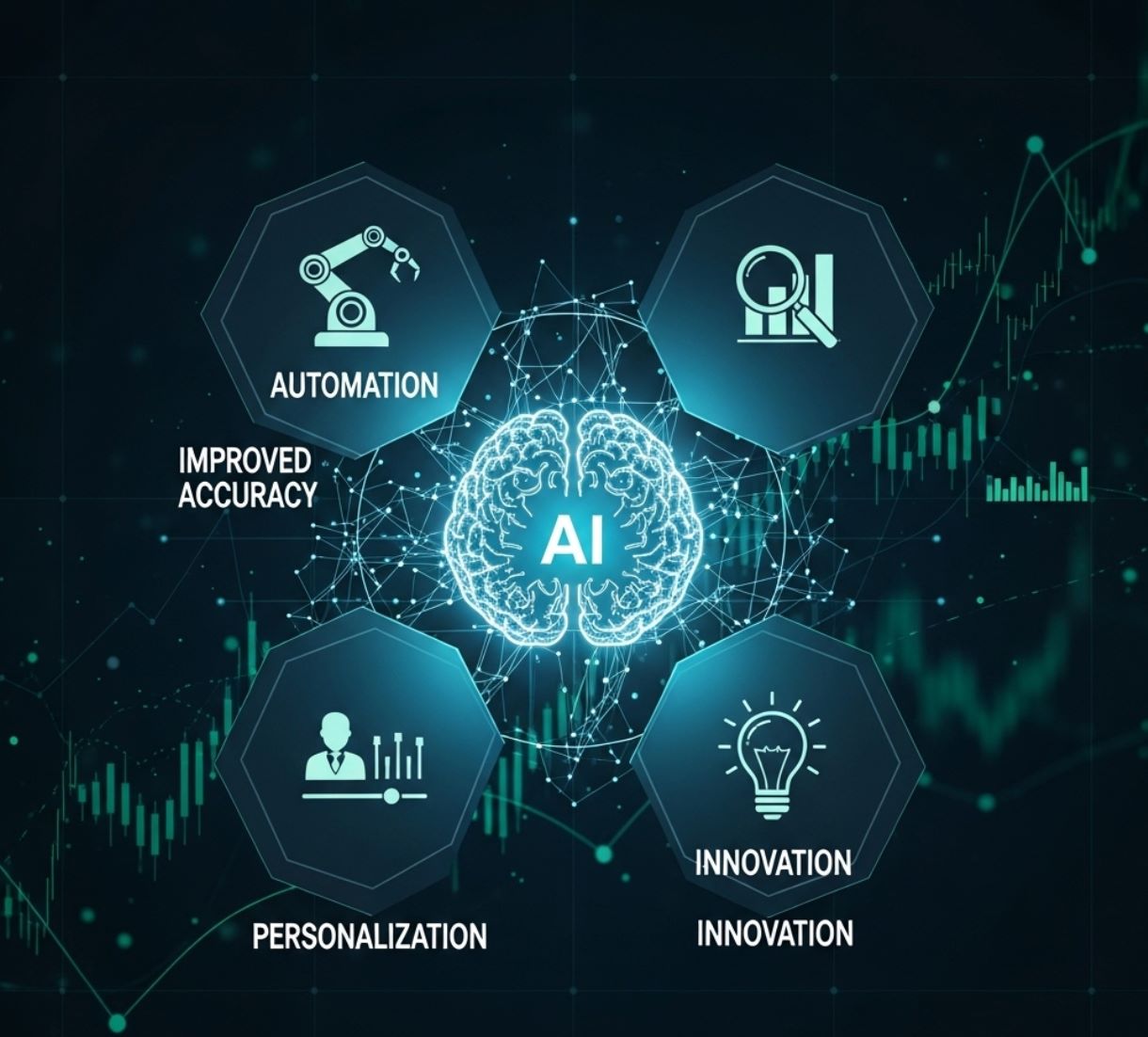
Applications of AI in Finance and Banking
AI is not just a buzzword in finance – it is already applied across many functions. Banks and fintechs use AI for fraud prevention, trading, personalization, credit analysis, compliance, and more.
Fraud Detection and Prevention
AI excels at spotting fraudulent activity in real time. Machine learning systems continuously analyze transaction streams to flag patterns indicative of fraud.
- Unusual payment amounts detection
- IP change monitoring
- Spending spike identification
- Evolving fraud tactic adaptation
Algorithmic Trading and Investment Analysis
AI-powered trading systems transform how assets are bought and sold by ingesting vast, diverse data and executing trades at high speed.
- Market price analysis
- News headline processing
- Social media sentiment tracking
- Economic report integration
Personalized Banking and Customer Service
AI revolutionizes customer-facing services by understanding individual profiles and offering personalized banking experiences.
- Best credit card recommendations
- Optimal loan product suggestions
- Savings plan customization
- 24/7 chatbot assistance
Credit Scoring and Underwriting
AI-based credit scoring analyzes a wider range of data than traditional models, providing a more holistic view of borrower creditworthiness.
- Transaction history analysis
- Online behavior assessment
- Psychometric indicators
- Alternative data integration
Regulatory Compliance (RegTech)
AI tools automate many compliance tasks, continuously scanning transactions and automatically generating reports.
- Anti-money laundering monitoring
- Automated report generation
- Anomaly flagging
- Regulatory change tracking
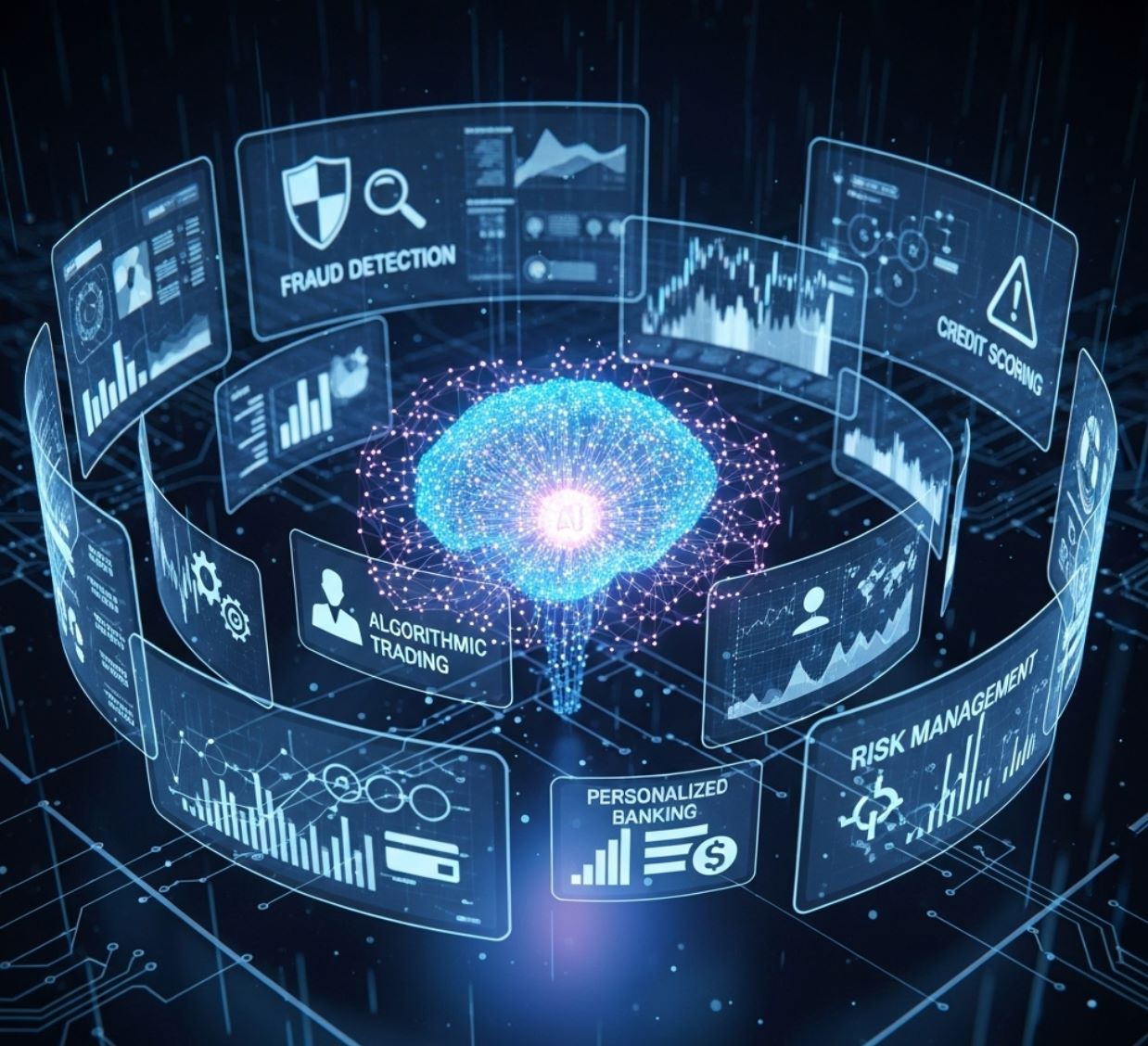
Risks and Challenges of AI in Finance
While AI brings great promise, it also introduces new risks and challenges that the financial sector must manage carefully. Key concerns include data security, model bias, regulatory gaps, and workforce impacts.
Data Privacy and Cybersecurity
AI systems require massive amounts of data – often including sensitive personal and financial information. This raises significant privacy and security risks.
Essential safeguards:
- Strong data governance frameworks
- End-to-end encryption
- Continuous monitoring systems
- GDPR and privacy law compliance
- Secured AI pipelines
As banks adopt AI, malicious actors are finding new targets in AI-driven systems. Without robust cybersecurity, the benefits of AI can be outweighed by the damage of data theft or tampering.
— EY Research Report
Algorithmic Bias and Transparency
AI models learn from historical data, so they can inadvertently replicate human biases. A well-known concern in finance is algorithmic bias in lending or investment decisions.
Addressing bias requires:
- Building explainable AI systems
- Using transparent models
- Adding interpretation tools
- Regular fairness testing
- Ethical AI frameworks
- Audit trail implementation
For instance, if an AI denies a loan, the bank must still explain the decision – but a complex AI model may not easily reveal its reasoning. Boards must insist on ethical AI, ensuring that bias is checked and outcomes are transparent.
Regulatory and Governance Challenges
The regulatory framework around AI in finance is still emerging. Currently, rules specific to AI are limited or unclear, creating uncertainty about compliance with future AI regulations.
Proactive governance approach:
- Form AI oversight committees
- Define accountability for AI outcomes
- Implement rigorous validation processes
- Engage regulators early
- Create audit trails for AI systems
- Involve legal, compliance, and technology teams
BCG recommends that banks "own the governance agenda" by engaging regulators early and creating audit trails for AI systems. Banks must align AI initiatives with strong governance to avoid regulatory pitfalls.
Workforce and Ethical Considerations
AI-driven automation may displace some banking jobs, especially those involving routine data processing. Back-office roles in data entry, compliance checks, and basic analytics could shrink.
Ethical considerations:
- Employee retraining programs
- Talent redeployment strategies
- Human-in-the-loop approach
- Accountability frameworks
- Transparency in AI processes
- Human oversight for responsible outcomes
Financial institutions need to balance efficiency gains with ethical use – embedding transparency and human oversight into AI processes to maintain trust and social license.
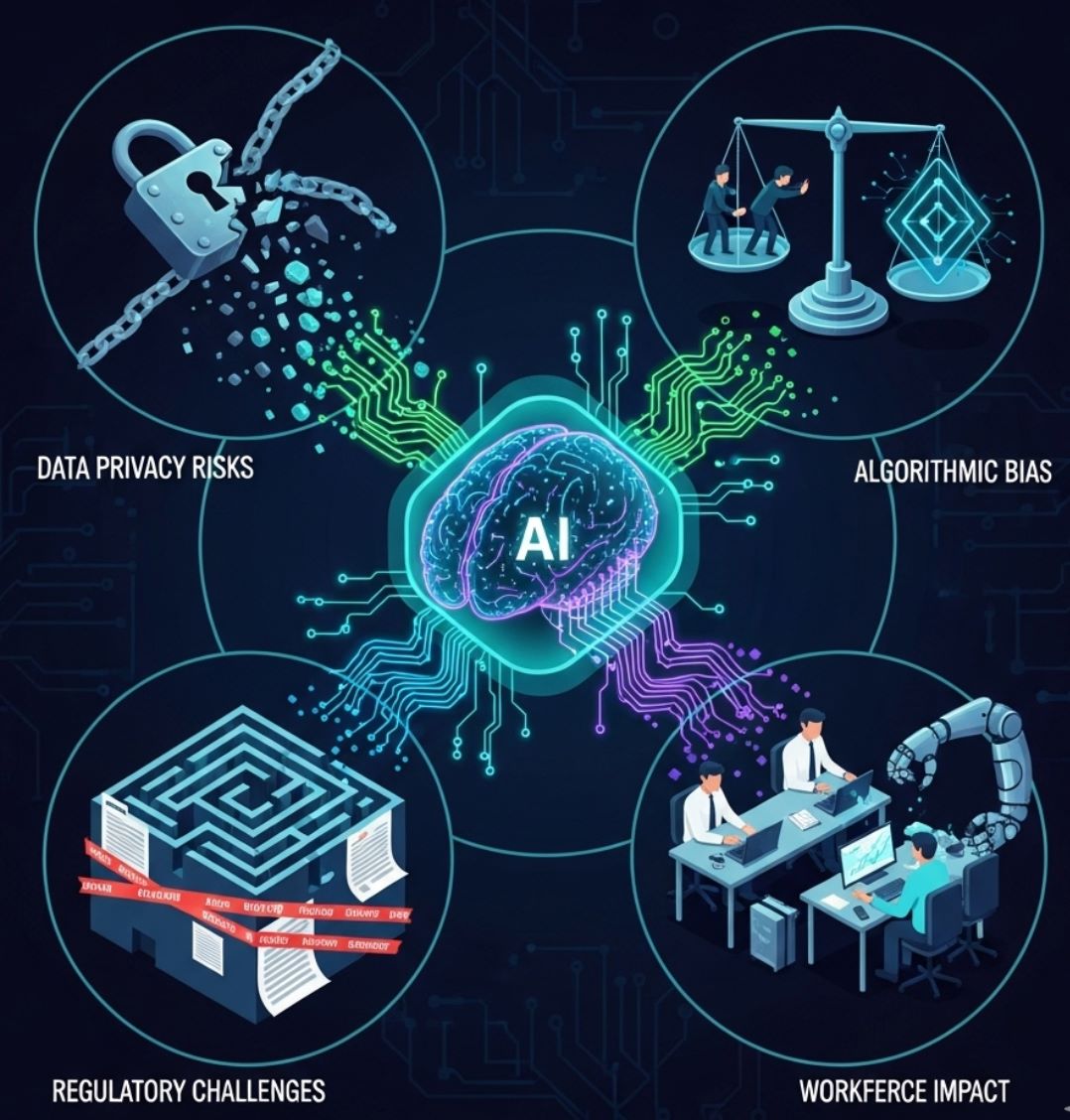
Strategic Implementation of AI
To capture AI's benefits while managing its risks, banks must adopt a strategic, holistic approach to AI implementation. This involves aligning AI efforts with business goals, investing in the right infrastructure, and upskilling talent.
Align AI with Business Strategy
Organizations should anchor AI initiatives in core business goals rather than treating AI as a siloed experiment. BCG emphasizes that banks "must anchor AI strategy in business strategy," focusing on projects with clear returns.
- Identify high-impact use cases (lending automation, wealth advisory)
- Set measurable performance metrics (revenue gain, cost reduction)
- Define AI vision tied to customer value
- Focus on competitive differentiation
Build Robust Data and Tech Infrastructure
Successful AI requires a strong technical foundation. Banks need unified data platforms, cloud or hybrid computing, and seamless integration layers to support machine learning at scale.
- Modernize legacy systems
- Adopt AI/ML platforms
- Ensure data quality
- Implement integration and orchestration layers
- Put AI at the center of tech and data
Establish Governance and Risk Controls
Robust governance is non-negotiable. Banks should create interdisciplinary AI risk committees and set standards for model validation and monitoring.
- Create AI risk committees
- Work with regulators proactively
- Develop risk management frameworks for auditability
- Define policies for data usage
- Ensure models can be audited
- Set ethical guidelines for credit decisions
Own the governance agenda by working with regulators and creating risk management frameworks geared for auditability and explainability.
— BCG Strategic Advisory
Develop Talent and Organizational Change
AI adoption often fails due to lack of skills or organizational resistance. Banks should invest in training and hiring AI talent while upskilling existing staff in data literacy.
- Hire data scientists and ML engineers
- Upskill existing staff in data literacy
- Realign roles and incentives
- Foster collaboration between teams
- Engage C-suite leadership
- Champion experimentation and learning
Isolated AI Projects
- Siloed experiments
- No clear ROI metrics
- Limited scalability
- Disconnected from business goals
- Minimal organizational buy-in
Enterprise AI Strategy
- Integrated across operations
- Measurable business impact
- Scalable infrastructure
- Aligned with core strategy
- Full leadership engagement
In short, winning banks treat AI as enterprise strategy, not a piecemeal project. They focus on delivering concrete ROI, embed AI into core processes, and align technology, risk, and people practices.
Research shows that banks currently investing strategically in AI (rather than just running isolated proofs of concept) set themselves up to "reshape how their business creates value." Those that move now – upgrading strategy, tech, governance, and talent in concert – will build stronger customer relationships, lower costs, and stay ahead of competitors.
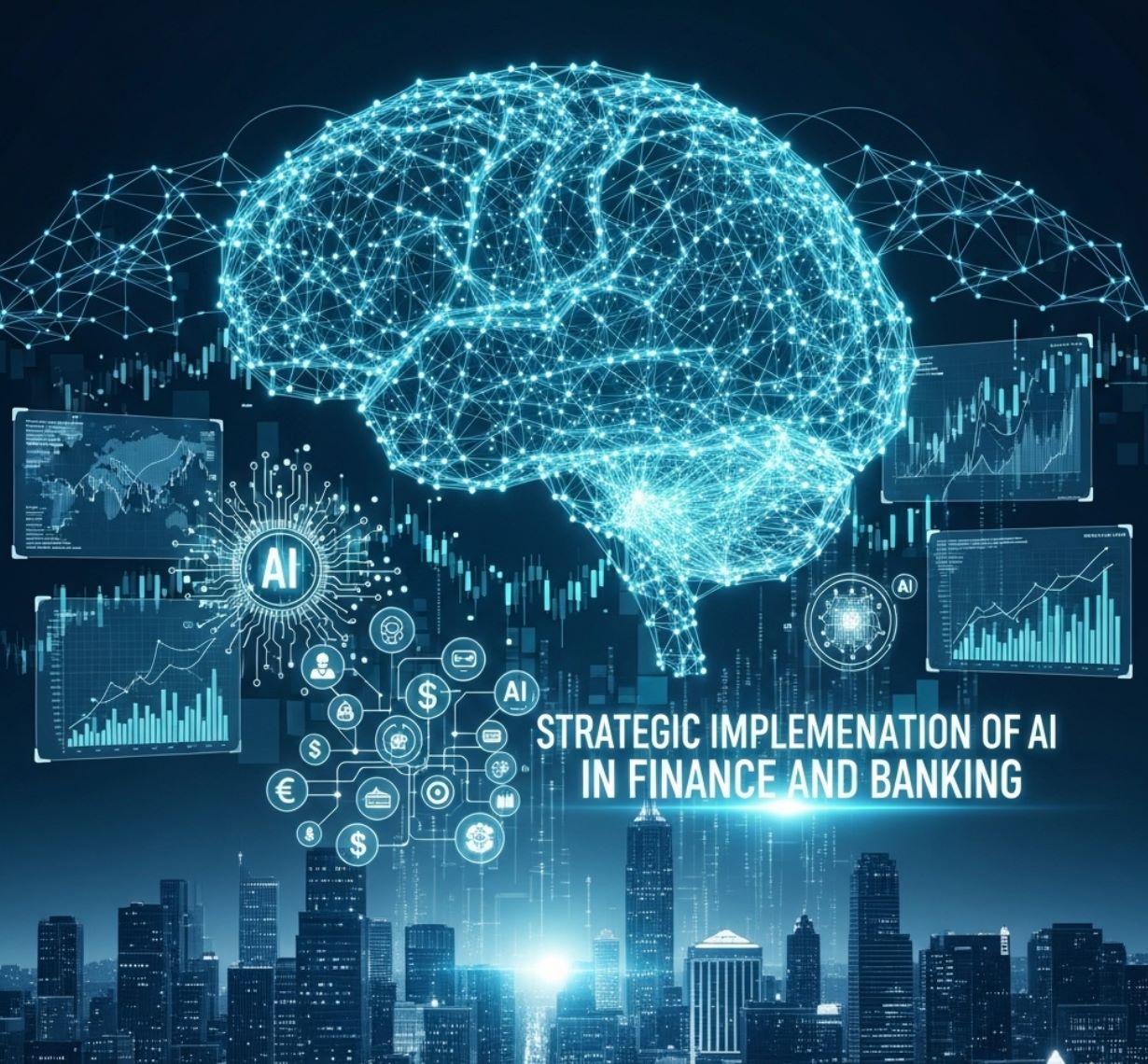
Future Outlook of AI in Finance
The future of the financial industry will be deeply AI-driven. Emerging AI technologies like generative and agentic AI promise to automate even more sophisticated tasks and unlock new capabilities.
Agentic AI Revolution
Economic Impact
Financial Inclusion
Emerging Capabilities
Personalized AI Financial Agents
Future AI will enable ever-more personalized and accessible finance through intelligent agents.
- Autonomous day-to-day finance management
- Tailored investment advice in real-time
- Instant micro-loan underwriting
- Personalized insurance products on-demand
Expanded Market Reach
AI could dramatically expand financial services to underserved populations.
- Loan assessments for smallholder farmers using local data
- Minimal infrastructure requirements
- Real-time credit decisions
- Accessible financial products for all
Regulatory Evolution
These advances bring fresh challenges that will shape the future regulatory environment. Regulators worldwide are already preparing AI frameworks (e.g. the EU's AI Act) and calling for greater transparency and accountability.
AI is no longer a fringe experiment; it's the engine of next-generation banking. Financial institutions that embrace this transformation now – aligning strategy, technology, governance, and talent – will be best positioned to thrive in the AI-powered future.
— Industry Expert Analysis
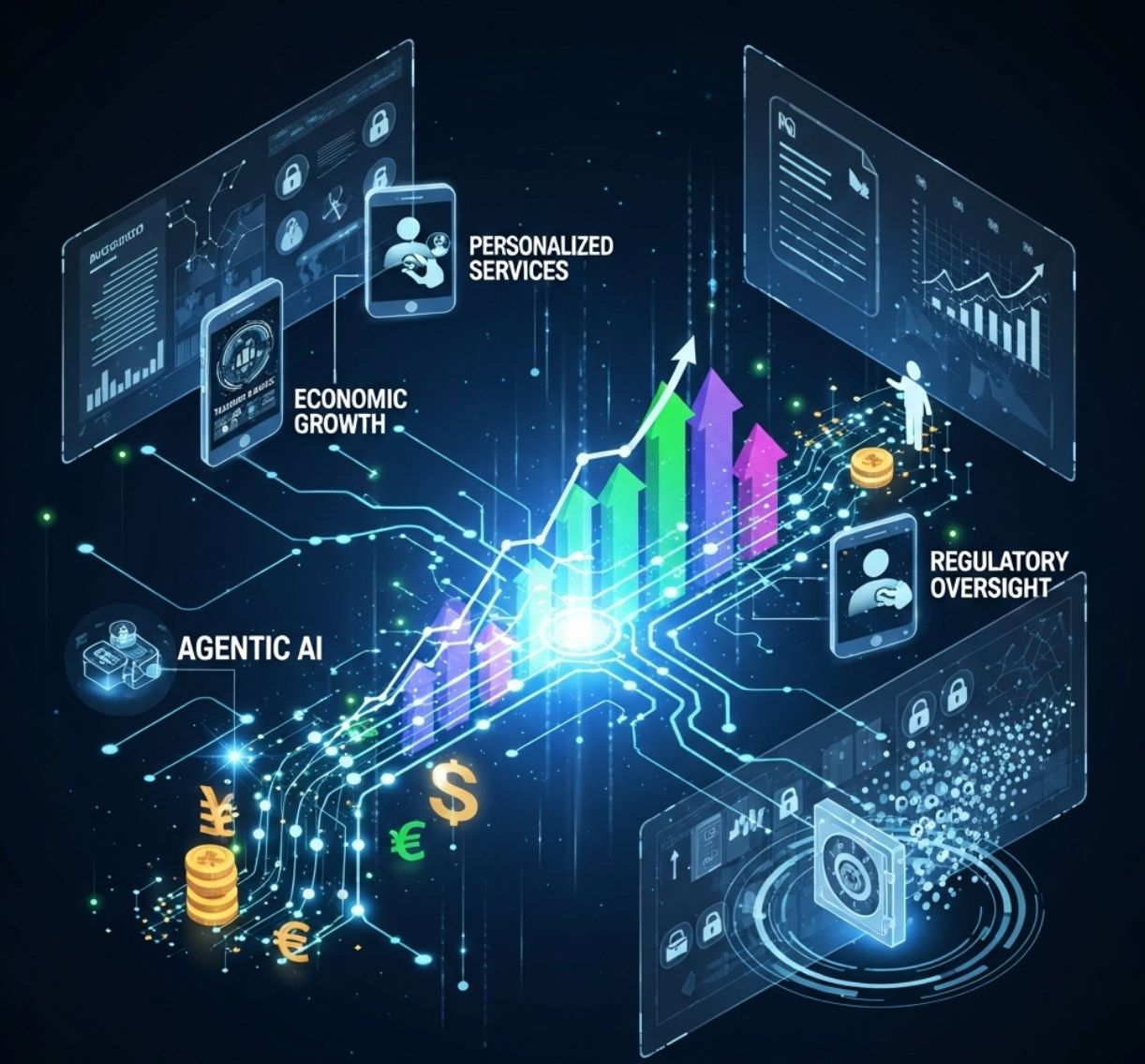
Top AI Tools in Finance and Banking
Feedzai
Feedzai is an enterprise risk platform specializing in real-time fraud detection, anti-money laundering (AML), and financial crime prevention. Using advanced AI and machine learning, Feedzai helps banks, fintechs, and payment processors monitor transactions, detect suspicious behavior, and reduce fraud losses while maintaining regulatory compliance. The company’s RiskOps framework unifies fraud, identity, and AML workflows under a single platform to deliver end-to-end protection across the financial lifecycle.
Personetics
Personetics is a fintech software company that helps banks and financial institutions deliver personalized, proactive money-management experiences. By analyzing real-time transaction and behavioral data, Personetics enables contextual insights, savings automation, overdraft warning, and customized financial advice. Its platform is deployed by leading banks worldwide to boost engagement, improve financial wellness, and grow customer lifetime value
Xapien
Xapien is a London-based AI SaaS platform specializing in automated due diligence and entity risk intelligence. It consolidates data from web sources, corporate registries, media, sanctions lists, and public records to generate deep, structured reports on individuals and organizations in minutes. Xapien enables compliance, legal, financial, and enterprise teams to uncover hidden risks, reputational connections, and contextual insights at scale.
Anaplan
Anaplan is a cloud-based enterprise planning and performance management platform that enables organizations to build integrated, scenario-driven models across finance, sales, supply chain, and operations. With its in-memory calculation engine and real-time recalculation architecture, Anaplan supports collaborative planning, forecasting, and decision-making at scale. The platform is designed for complex, dynamic business contexts, allowing users to respond rapidly to change with updated plans and insights.
Conclusion
AI's role in finance and banking is poised to grow immensely. We can expect more data-driven decision-making, intelligent automation, and customer-centric innovation ahead.
Automation
Analytics
Personalization
Security
Financial institutions that embrace this transformation now – aligning strategy, technology, governance, and talent – will be best positioned to thrive in the AI-powered future.






Comments 0
Leave a Comment
No comments yet. Be the first to comment!